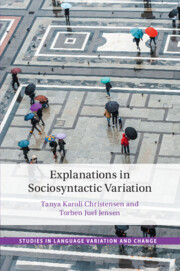Book contents
- Explanations in Sociosyntactic Variation
- Studies in Language Variation and Change
- Explanations in Sociosyntactic Variation
- Copyright page
- Contents
- Figures
- Tables
- Contributors
- Series Editor’s Preface
- Acknowledgements
- Introduction: Analysing and Explaining Syntactic Variation
- 1 Comparing Syntactic Variables
- 2 Mapping Syntax and the Sociolinguistic Monitor
- 3 A Columbia School Perspective on Explanation in Morphosyntactic Variation
- 4 On the Inevitability of Social Meaning and Ideology in Accounts of Syntactic Change: Evidence from Pronoun Competition in Netherlandic Dutch
- 5 The Predictability of Social Stratification of Syntactic Variants
- 6 When Variants Lack Semantic Equivalence: Adverbial Subclause Word Order
- Index
- References
6 - When Variants Lack Semantic Equivalence: Adverbial Subclause Word Order
Published online by Cambridge University Press: 06 January 2022
- Explanations in Sociosyntactic Variation
- Studies in Language Variation and Change
- Explanations in Sociosyntactic Variation
- Copyright page
- Contents
- Figures
- Tables
- Contributors
- Series Editor’s Preface
- Acknowledgements
- Introduction: Analysing and Explaining Syntactic Variation
- 1 Comparing Syntactic Variables
- 2 Mapping Syntax and the Sociolinguistic Monitor
- 3 A Columbia School Perspective on Explanation in Morphosyntactic Variation
- 4 On the Inevitability of Social Meaning and Ideology in Accounts of Syntactic Change: Evidence from Pronoun Competition in Netherlandic Dutch
- 5 The Predictability of Social Stratification of Syntactic Variants
- 6 When Variants Lack Semantic Equivalence: Adverbial Subclause Word Order
- Index
- References
Summary
This chapter argues that it will make results of variationist studies more relevant for linguistic theory if internal predictors assumed to constrain syntactic variation are operationalized in a way that explicitly relates them to semantic or – more broadly – functional hypotheses. We use word order in Danish adverbial subordinate clauses as a case study for how a hypothesized semantic difference between variants can be operationalized. This word order alternation concerns the relative placement of sentential adverbials and finite verbs in subclauses. While the variable is structurally well defined (Adverb < Verb vs. Verb > Adverb), it challenges classic theoretical and methodological ass+L13umptions in variationist studies by entailing a semantic difference, since the two word orders convey subtly different meanings when used in subclauses. For this study, we operationalize a set of linguistic predictors related to the two most prevalent meaning hypotheses given in the literature, the assertivity and the foregrounding hypothesis. Mixed-effect models and random forest analyses are used to examine the effects and strength of intra- and extralinguistic (social) predictors. Geographical differences related to social stratification indicate an ongoing standardization process emanating from the capital of Copenhagen. The import of our findings related to linguistic theory is discussed.
Keywords
Information
- Type
- Chapter
- Information
- Explanations in Sociosyntactic Variation , pp. 171 - 206Publisher: Cambridge University PressPrint publication year: 2022
References
Accessibility standard: Unknown
Why this information is here
This section outlines the accessibility features of this content - including support for screen readers, full keyboard navigation and high-contrast display options. This may not be relevant for you.Accessibility Information
- 3
- Cited by
